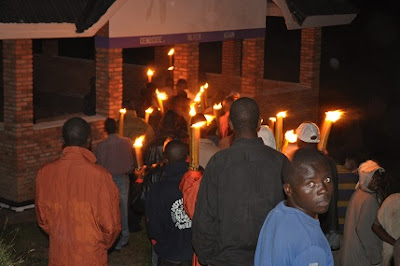 |
| Country Director Mary Abrams and me hanging out in her office for an interview. |
In September 2010, Mary Abrams became the second Peace Corps Rwanda country director since the program was re-established in 2008. As with many of the Peace Corps staff, Mary has led an interesting and varied life. A Doctorate, travel, and management were all common knowledge of her background, but the current Peace Corps Rwanda volunteers know almost nothing about Mary. Is she married? What are her responsibilities? What did she do before the Peace Corps? Nobody could give me an answer. So I decided to interview her for a blog post (where she became self-conscious yet candid when talking about herself) and find out for myself:
Steven Anderson (SA): After talking with other Peace Corps volunteers, we didn’t even know if you are married. Do you have children?
Mary Abrams (MA): I married just before I took my assignment in Niger (approximately five years ago). I have no children, but I have two cats that are here with me in Rwanda named Bête and Mousse (French pronunciation).
SA: How did you come from a college graduate to a Peace Corps Rwanda country director?
MA: After earning my bachelors degree in agronomy, I worked in theatre for a year. After that, I became a Peace Corps volunteer from 1979 to 1981 in Niger focusing on agronomy. I stayed on in Niger until 1984 working with USAID on an agricultural project. Upon returning to the United States, I earned a PhD in soil science with a dissertation focusing on environmental issues. I worked for five years as a research professor and traveled all over the world for my job researching and teaching natural resource management. I then moved on to work as an environmental scientist for the City of Portland, Oregon and then as a water quality technician on the Snake River for the Oregon Department of Environmental Quality (ODEQ). After that I returned to Portland to manage a division for ODEQ. Due to my experience in management, working with volunteers and in the public sector as well as work with emergency response/public safety, I was fortunate enough to come back to the Peace Corps as a director in Niger (West Africa) for four years. After my Niger tour, I came to Rwanda as a country director.
SA: How did your experience as the country director for Peace Corps Niger prepare you for your assignment in Rwanda?
MA: I learned a lot about the bureaucracy of the Peace Corps and knowing where to go for help. With the security issues in Niger, I learned a lot about safety and security and how to work with the United States embassy to keep up to date and have good communication on the ground. Furthermore, I discovered a lot of the issues that current Peace Corps volunteers have now that didn’t exist when I was a volunteer.
SA: How did work outside the Peace Corps world prepare you to be a volunteer and country director?
MA: My educations as a soil scientist and growing up in a rural area helped me with my primary assignment as a volunteer while serving in a very rural area in Niger.
Prior to being a country director, my experiences in management and office responsibilities were vital to directing an entire country office. I also have worked and lived overseas which gave insight into overcoming challenges from different personalities/priorities/cultural situations when working on projects in a multi-cultural environment.
SA: What are a country director’s responsibilities and day to day tasks?
MA: I’m responsible for all staff, volunteers, and property with the exception of medical oversight of medical staff and I am not the contracting officer for the office. I am the liaison between the main PC headquarters in Washington DC, volunteers, the Government of Rwanda, and the US Embassy in Rwanda. I set policy and make decisions with the staff on how to implement that policy for PC Rwanda. I spend too much time in front of the computer and would like to spend more time on the road visiting PCVs.
SA: How often do you make it back to the US?
MA: I try to go home once a year to Portland and take a break every six months somewhere around the world.
SA: What are you hoping to accomplish during your tenure as the Peace Corps country director of Rwanda?
MA: I’m hoping to finish the startup work that began in 2008 which includes building on relationships that have been established, most importantly the contacts that help serve the most immediate needs of Rwandans.
SA: You’ve traveled to a lot of countries, which ones are your favorite and why?
MA: It depends on how you define “favorite.” If you’re looking strictly for warm, friendly people, my place to go is Niger or France. For greenery, civic engagement and country development, I think Rwanda is the best place I’ve been. For scenery I would go to the Namib Desert in Namibia. My favorite vacation place is France because of the food, wine, and great places to visit.
SA: Moving from foreign country to foreign country can make this difficult, but what hobbies and pastimes do you try to keep?
MA: I love to read, practice yoga, and run. What’s great about the Peace Corps is getting the chance to read. I love watching movies, and over the years I have been able to amass a large collection of my favorite movies.


